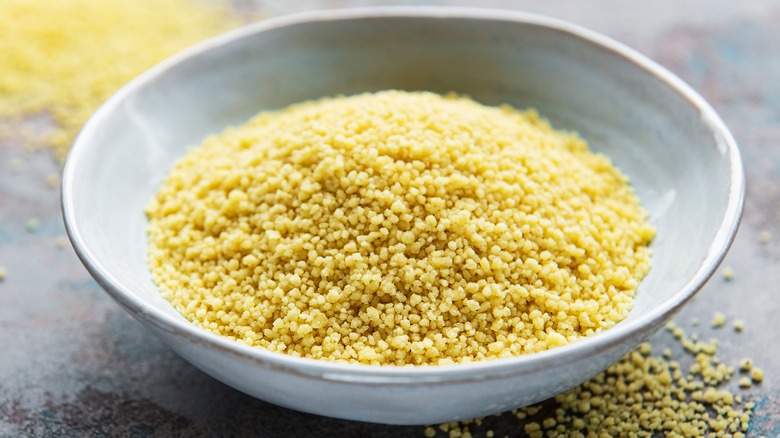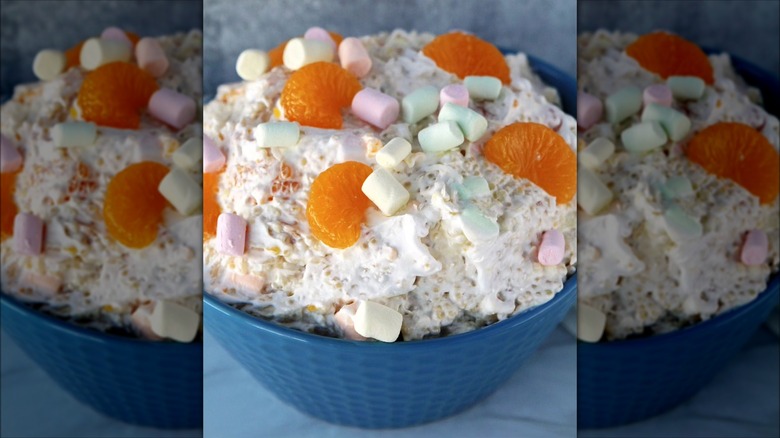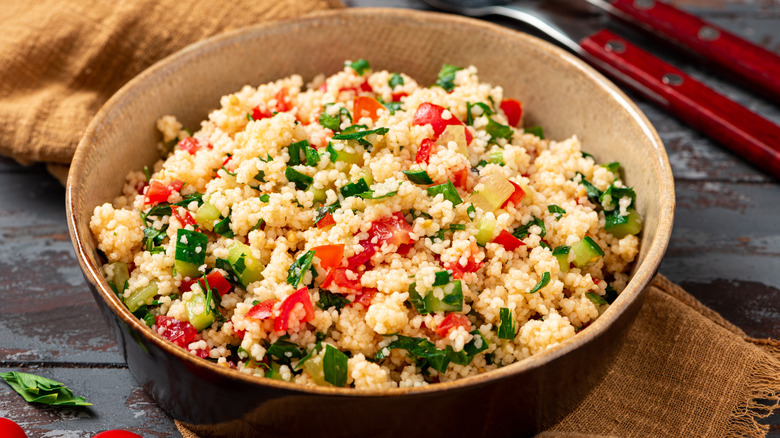The Nutty Difference Between Acini De Pepe And Couscous
At first glance, it would seem that acini de pepe and couscous could be used interchangeably in dishes. They're both made out of semolina, and the tiny spheres look identical to each other. But that's where the similarities end. They originated in different parts of the world, with different techniques for their creation and cooking, and have distinctly different flavors.
Couscous is made of crushed semolina that is rolled with your hands, while acini de pepe is made from ground semolina flour. Couscous originated in North Africa, though there are several kinds that are also associated with the Middle East. Acini de pepe originated in Italy and is made similar to other pastas, from a dough created with semolina flour. Couscous also has a nuttier, sweeter flavor due to the unprocessed, coarse semolina used, and this nutty flavor is increased if the couscous is toasted. While it's common to think of couscous as a grain, it's actually pasta since it's made with semolina wheat flour and water.
Both are made from semolina flour, so their nutritional benefits are similar. While couscous is less processed than acini de pepe, both have high amounts of fiber, protein, and selenium. The antioxidant selenium can improve your immune system and also lower inflammation. Studies have shown that it may also help protect against certain cancers, and is essential for your thyroid to function properly.
How acini de pepe is prepared and eaten
The word acini de pepe translates to peppercorns in Italian, which is in reference to their size, not taste. Even so, acini de pepe pasta is even tinier than peppercorns and falls in the family of pasta referred to as pastina. Pastina isn't a type of pasta but a category of very small varieties of pasta. They can be star-shaped, round, or cylindrical. One of the easiest to find is orzo pasta.
Acini de Pepe is cooked similarly to other pasta. Bring a pot of salted water to a bowl, add pasta, and cook at a low boil. Because the pasta is smaller, it only needs to cook for somewhere between 4 to 9 minutes, with al dente typically reached at 6 minutes.
Acini de pepe is a symbol of fertility, which is how many think it ended up being used to make Italian Wedding Soup. In fact, because of its texture and ability to soak up flavors, it's used as the base for many soups and broths. Besides being popular for soups, acini de pepe is also the main ingredient in many cold salads. Notably, it plays a starring role in Frog's Eye Salad, a pasta-and-Cool Whip combo that was featured on the back of Creamette boxes in the 1960s and 70s. The combination of cold noodles, pineapple, mandarins, marshmallows, coconut, and Cool Whip was a staple at Midwest and Southwest holidays and potlucks.
How couscous is prepared and eaten
Historians believe that couscous became a food staple among the Berbers of Algeria and Morocco between the 11th and 13th centuries. To make couscous, coarsely ground durum wheat is sprayed with salt water and rolled and rubbed with the fingers until it forms small clumps. It is pressed through a sieve, steamed, then dried. Moroccan couscous is made with coarse semolina and steamed three times in a couscoussier (couscous steaming pot). This makes it similar to the type of couscous we usually buy, which has been steamed and dried and just needs to be reconstituted with boiling water.
Most couscous is cooked at a 1:1 ratio with liquid, and rather than being boiled in the water or broth, as pasta is, it is mixed with the boiling liquid and left to steam. Sometimes the couscous is toasted in butter for a few minutes, which adds even more of a nutty flavor. The three most popular kinds of couscous are Pearl (Israeli), Lebanese, and Moroccan, and a common mistake people make when making couscous is not realizing they bought Pearl couscous, which needs to be boiled.
In Morocco, the term "couscous" refers to both the processed grain and the meal itself, which involves various spices, vegetables, and meats laid on top. Lamb is popular, but beef or chicken can also be used. In Morocco, families often eat it together every Friday after prayers. For everyday cooking, couscous is an incredibly quick and versatile backdrop for salads, stir-fries, meat, or stews.


